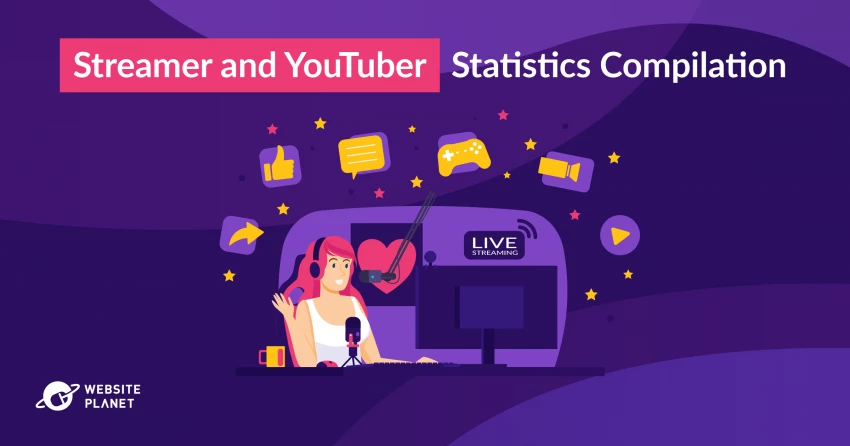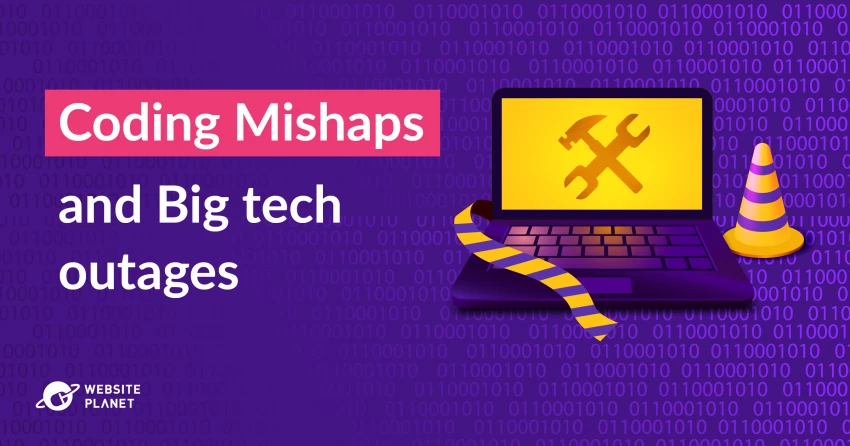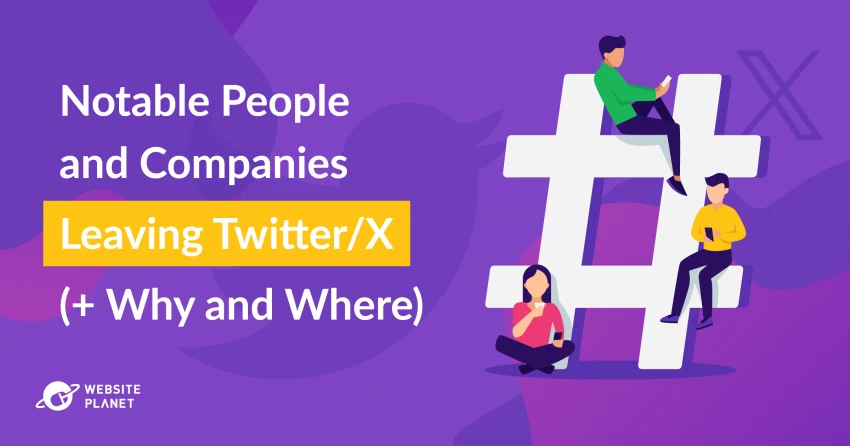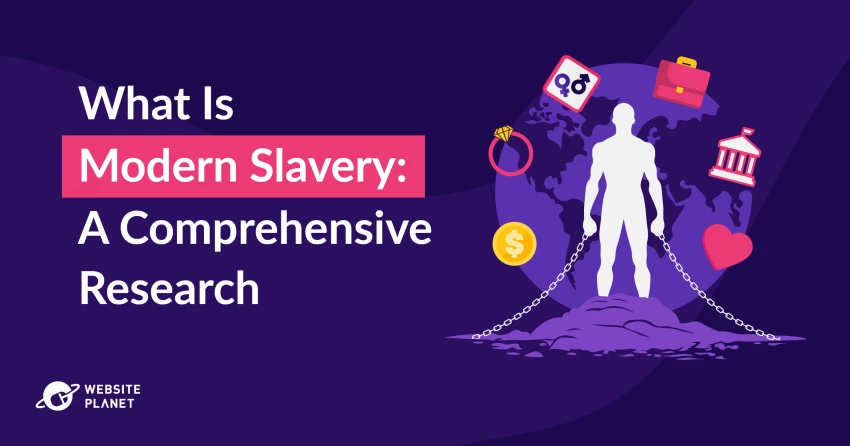Being a content creator is now one of the most popular career choices. Fueled by the rise of multiple social media platforms, influencers now rival traditional entertainers. The creator economy that supports them is growing fast and is projected to reach $480 billion by 2027, according to Goldman Sachs.
But can this growing industry actually support the millions who want to join it?
Successful content creators exist, but stable careers seem to be an exception. So, we at Website Planet decided to look into these exceptions — who breaks through, what they’re doing differently, and whether content creation can actually deliver economic opportunity beyond the top few creators.
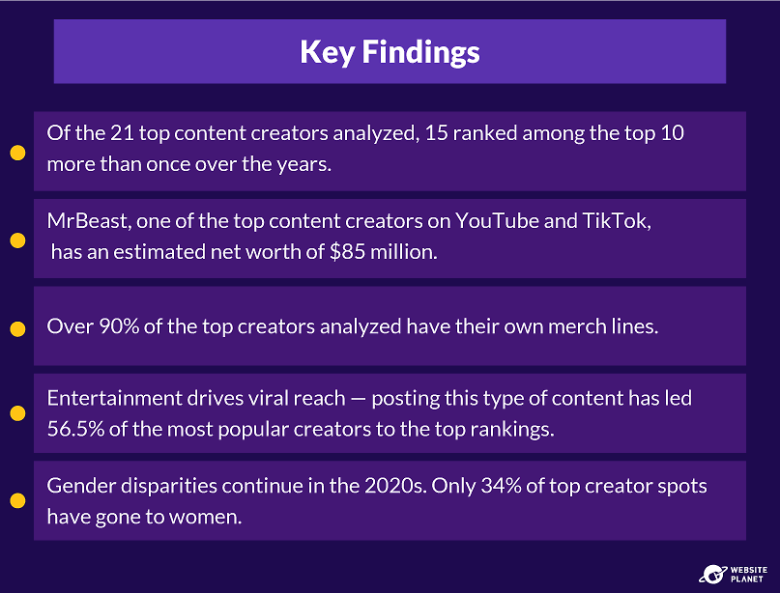
Visibility by the Numbers (2020 to mid-2025)
In the creator economy, staying at the top isn’t anymore just about originality or engaging with followers. Platform dynamics also play an important role.
From algorithm boosts to favored content formats, platforms like YouTube, TikTok, and Twitch, often shape long-term visibility more than individual momentum alone.
This article takes a look at five complete years (2020-2024) and partial data from 2025 to examine how visibility has evolved across these three platforms. We track which creators consistently ranked among the annual top 10, and how each platform rose, plateaued, or rebounded in the ongoing competition for audience attention.
Who Really Dominates the Creator Economy?
While millions compete for visibility, only a small group of creators consistently dominate the top rankings.
To find out who, we looked at the most-followed creators on TikTok, Twitch, and YouTube. For each platform, we listed the creators who had the highest follower count each year. Then, we tallied how many times each creator appeared in these top rankings. This allowed us to track not just who broke through once, but who managed to return year after year.
As shown in the chart above, 21 unique creators appeared in the top rankings at least once between 2020 and 2025. Of those, 16 creators (76%) held the spotlight for at least two years, with some claiming a top spot as many as five times.
The fact that a few individuals rank at the top year over year suggests that, as a new creator, it’s hard to stay relevant — especially when competing against early viral stars or creators with strong cross-platform reach (like MrBeast, whose follower count is one of the highest on both YouTube and TikTok).
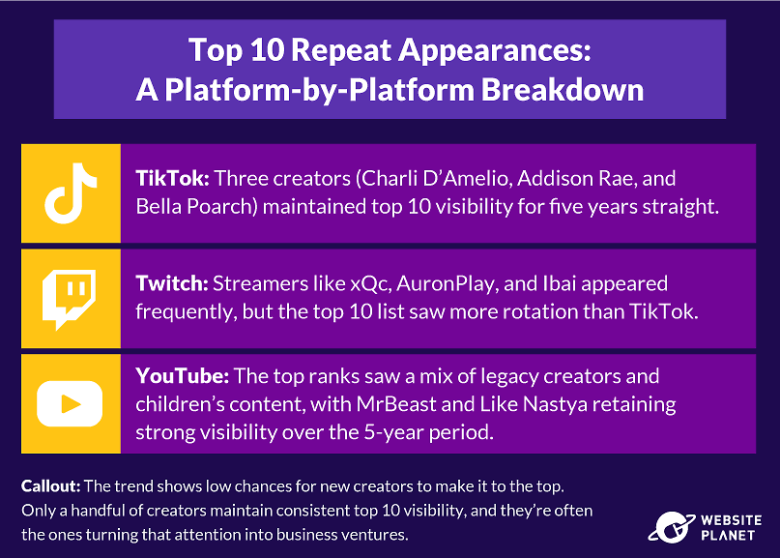
Creators like Charli D’Amelio, Bella Poarch, and xQc consistently ranked among the most followed on TikTok and Twitch for the last five years. Their continued visibility can be attributed to early breakout success, high engagement, and smart use of platform features and trends — but not just that.
These creators stayed dominant by going beyond content and through platform partnerships, sponsorships, merch, brand ventures, and mainstream media deals. But before we delve into that, let’s go over what it takes to get to the top: What type of videos did they make? How many followers did they have to get?
Content Categories That Lead the Market
To succeed, creators need to align with audience interest and content trends (even if they seem to be constantly changing).
To understand which types of content dominated the top rankings, we went back to the 21 most popular creators we mentioned above. This time, though, we focused on the motif of their videos and assigned a primary content category to each creator (gaming, lifestyle, comedy, etc.).
If a creator appeared on the most-followed list for multiple years, each appearance was added to that same content category total. So, for example, if xQc ranked in Twitch’s top 10 for 4 different years, and he is primarily known for gaming-related streaming, that added four points to the “gaming” category.
This approach allowed us to track not just which creators are popular, but which content types maintained high visibility over time across all three platforms.
From 2020 to mid-2025, entertainment-focused creators dominated over half of all top spots. The type of entertainment varied — dance, lip-sync, and viral comedy formats, for instance, were particularly popular on TikTok.
Gaming was the second most popular category, while smaller but emerging segments (like commentary-based videos) suggest a shift toward influencer-centered content.
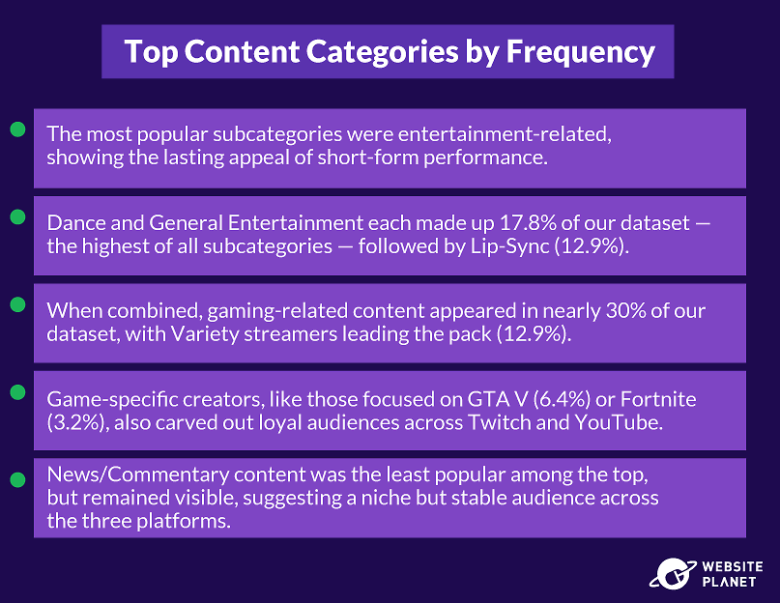
The overall trend shows that Entertainment-focused content drives short-term viral success. Nevertheless, Gaming’s diversity and interactive formats are quickly gaining ground, offering creators new ways to build lasting audience loyalty.
But how many loyal followers does it take to reach peak popularity on each platform?
Follower Trends for Top Streamers
To understand what it takes to stay at the top, we also analyzed the average follower counts of creators who ranked as the most popular on each platform over the years. From 2020 to mid-2025, TikTok, Twitch, and YouTube each carved its own growth path.
The chart below shows how, with a platform’s growing popularity, a higher follower count is needed to reach or remain in the top rankings.
Compared to 2020, the average follower count has seen a notable increase over the years. TikTok’s top streamers went from an average 75 million followers to over 100 million by 2025. Meanwhile, YouTube’s top creators saw a more dramatic increase — their following count jumped from an average 43 million to over 205 million in just five years.
Unfortunately, there was no available data regarding YouTube’s most popular creators in 2022-2024. This was due to the platform’s algorithm shift to quality and engagement over subscriber size. Initiatives like Hype (2023) focused more on new and small-following creators, reducing visibility of follower-heavy accounts.
Twitch remained relatively steady from 2021 to 2022, with its top streamers averaging between 8 to 10 million followers. This stability can be attributed to its shift from relying solely on legacy influencers toward nurturing highly engaged, new talents like Kai Cenat.
The truth is that, while individuals drive the creator economy, it’s often the platforms that determine who rises or disappears from view. Moreover, audience habits and content formats can reshape platform visibility, and a platform itself can rise or fall in popularity.
Twitch, for instance, had been slowly growing in popularity since its launch in 2011, but it surged in 2020, likely due to an increasing demand for live, interactive content during the pandemic. Since its peak in 2021, viewership has been slowly decreasing, though it still records over 2 million concurrent viewers on average.
YouTube, on the other hand, seemed to take advantage of the trends and launched its own short-format video feature in 2021. YouTube Shorts now averages 200 billion views a day, reflecting YouTube’s enduring appeal even amid rising competition from platforms like TikTok.
How Leading Creators Monetize Their Influence
Compared to traditional entertainment figures, top streamers are rapidly closing the gap in both revenue and influence. Between 2020 and mid-2025, top creators didn’t just attract followers — they turned their internet influence into full-scale businesses.
In this section, we looked into how the same top 21 leading streamers have made their fortunes. Like before, this group was selected because they were either highly ranked by follower count or consistently appeared in platform-specific top 10 lists.
You can see a summary of our findings in the table below. We relied on available public data for the creators’ estimated net worths and business ventures. There may, of course, be other contributing factors to the creators’ financial success, but we tried to include enough verified information to get a broader comparative view of the top creators’ reach and monetization.
YouTube ads, Twitch subs, and TikTok’s Creator Fund provided a base income for these creators. However, their wealth came from merch lines, exclusive streaming deals, music and acting careers, brand partnerships, and even product launches.
One of the most striking examples is MrBeast, the highest-valued creator today, with an estimated net worth of $85 million. His wealth comes not just from his massive YouTube following base (200M+ subscribers) and big sponsorship deals, but also from his own food brands: Beast Burger and Feastables.
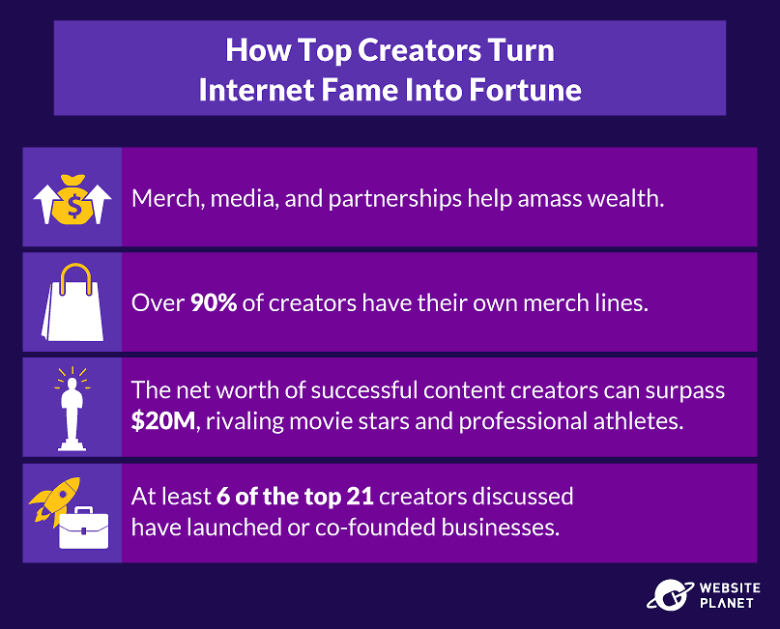
The modern creator economy shows a clear pattern: viral fame may launch a career, but lasting wealth comes from transforming influence into business.
Gender Disparities in Creator Fame
While repeat success shows who mastered the creator economy, it also highlights how unequal access to the top can be. In this section, we break down the numbers to see how gender may determine who enters the top rankings.
From 2020 to 2025, 66% of top rankings across TikTok, Twitch, and YouTube went to male creators, with females making up just 34% of the most popular influencers on these platforms. Moreover, no creators identified as Other or Non-binary during this period.
This pattern highlights an uncomfortable truth — that even in new media, old structural imbalances remain.
Take the 2021 Twitch boycott campaign, for example. With the hashtag #ADayOffTwitch, creators like Rek It Raven, LuciaEverBlack, and ShineyPen led the movement to protest the platform’s failure to address targeted harassment.
Potentially similar dynamics play out on TikTok, where many female creators report that their content is deprioritized by the algorithm unless it aligns with narrow beauty standards.
These policies don’t just impact creators’ mental health but also shape audience expectations, limit the kinds of content women are encouraged to make, and ultimately determine who gains visibility and rises in the rankings.
Discussion
The creator economy presents attractive employment and entrepreneurship opportunities, but success is not evenly distributed.
While millions may hope to turn content creation into stable careers, our analysis shows that long-term success is rare. A small group of creators continues to dominate, benefiting from early success, smart business strategies, and platforms that favor well-established names.
Moreover, changes in platform rules, algorithm updates, and gender disparities make it a constant challenge for most to reach and stay at the top.
One thing’s for sure though; while difficult, it’s not impossible to become a successful content creator.
Methodology
The article tracks the top digital creators on TikTok, YouTube, and Twitch from 2020 and 2025. The goal was to see which creators were the most popular each year based on public data like follower counts, subscriber numbers, and viewership.
Our research team collected data manually from public sources, including:
- YouTube: SocialBlade, Statista, and Wikipedia
- Twitch: TwitchTracker and Dexerto
- TikTok: SocialBlade, Countik, and Wikipedia
- Financial estimates (for some creators): Forbes, Business Insider, and Tasty Edits
To be included, creators had to appear in a platform’s top 10 by followers or subscribers in any given year. When exact rankings weren’t available, we used supplementary metrics like total view counts, industry recognized awards, or media coverage.
Where historical data was incomplete, especially for TikTok and YouTube before 2022, we made conservative estimates based on growth trends. All estimates were verified using at least two sources (e.g., Wikipedia + SocialBlade) when possible.
This study focuses on visibility, not earnings. While we mention how creators make money, financial analysis was not the main focus of this article.
Key limitations include missing or incomplete data (especially for TikTok and YouTube) before 2022, use of ranking based on follower/subscriber numbers, not active engagement or earnings, and changes in platform algorithms that affected creator visibility across years.
Despite these limitations, the data offers a clear view of who reached the top and how difficult it is to stay there.
